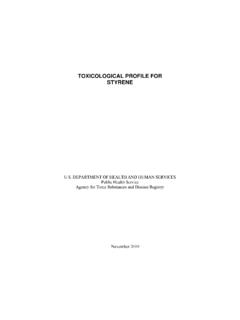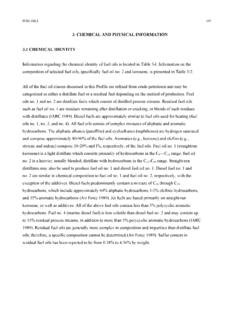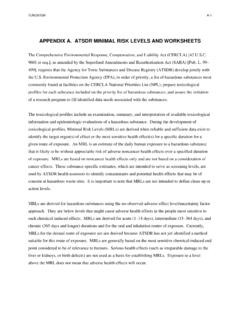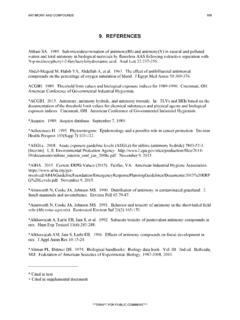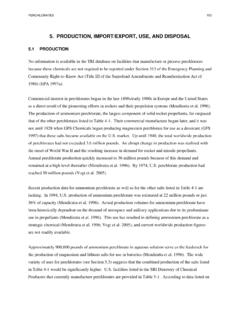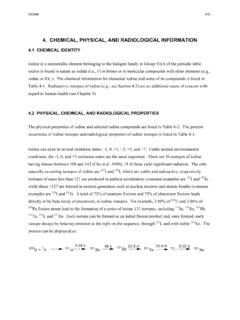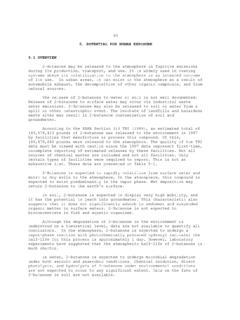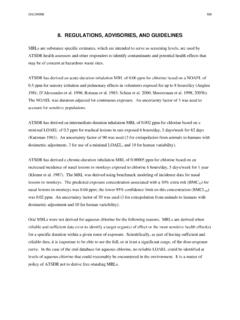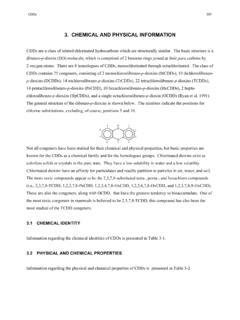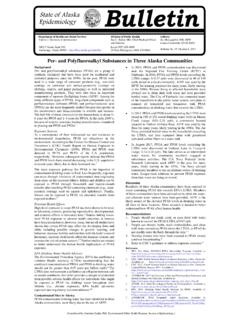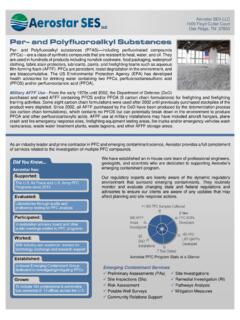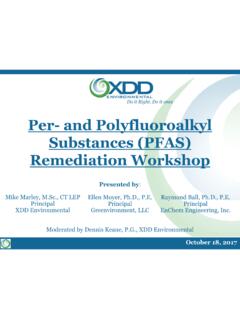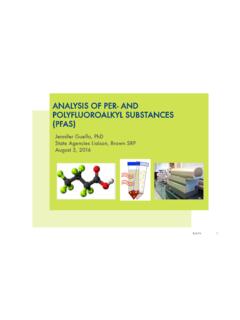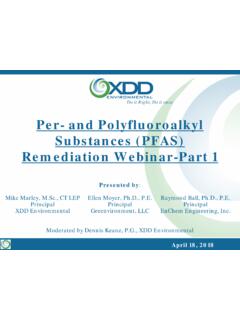Transcription of An Overview of Perfluoroalkyl and Polyfluoroalkyl ...
1 An Overview of Perfluoroalkyl and Polyfluoroalkyl Substances and interim guidance for Clinicians Responding to Patient interim guidance Exposure Concerns Revised on 6/7/2017. Introduction The purpose of this fact sheet is to provide interim guidance to aid physicians and other clinicians with patient consultations on Perfluoroalkyl and Polyfluoroalkyl substances (PFAS). It highlights what PFAS are, which chemicals fall into this category of substances, identifies health effects associated with exposure to various PFAS, and suggests answers to specific patient questions about potential PFAS exposure. Background What are PFAS? PFAS, sometimes known as PFCs, are synthetic chemicals that do not occur naturally in the environment.
2 There are many different types of PFAS such as perfluorocarboxylic acids ( , PFOA, sometimes called C8, and PFNA) and perfluorosulfonates ( , PFOS and PFHxS). PFAS may be used to keep food from sticking to cookware, to make sofas and carpets resistant to stains, to make clothes and mattresses more waterproof, and to make some food packaging resistant to grease absorption, as well as use in some firefighting materials. Because PFAS help reduce friction, they are also used in a variety of other industries, including aerospace, automotive, building and construction, and electronics. Why are PFAS a possible health concern? According to the Environmental Protection agency (EPA), PFAS are considered emerging contaminants.
3 An emerging contaminant is a chemical or material that is characterized by a perceived, potential, or real threat to human health or the environment or by a lack of published health standards. PFAS are extremely persistent in the environment and resistant to typical environmental degradation processes. The pathway for dispersion of these chemicals appears to be long-range atmospheric and oceanic currents transport. Several PFAS and their potential precursors are ubiquitous in a variety of environments. Some long-chain PFAS bioaccumulate in animals and can enter the human food chain. PFOS and PFOA are two of the most studied PFAS. Exposure to PFOA and PFOS is widespread and global.
4 PFOS and PFOA also persist in the human body and are eliminated slowly. Both PFOS and PFOA can be found in blood, and at much lower levels in urine, breast milk and in umbilical cord blood. PFOS and PFOA may pose potential adverse effects for human health given their potential toxicity, mobility, and bioaccumulation potential. The likelihood of adverse effects depends on several factors such as amount and concentration of PFAS ingested as well as the time span of exposure. Routes of Exposure and Health Effects What are the main sources of exposure to PFAS? For the general population, ingestion of PFAS is considered the major human exposure pathway.
5 The major types of human exposure sources for PFAS include: - Drinking contaminated water. - Ingesting food contaminated with PFAS, such as certain types of fish and shellfish. - Until recently, eating food packaged in materials containing PFAS ( , popcorn bags, fast food containers, and pizza boxes). Using PFAS compounds has been largely phased out of food packaging materials. - Hand-to-mouth transfer from surfaces treated with PFAS-containing stain protectants, such as carpets, which is thought to be most significant for infants and toddlers. National Center for Environmental Health agency for toxic Substances and disease registry - Workers in industries or activities that manufacture, manipulate or use products containing PFAS may be exposed to higher levels than the general population.
6 What are other low level exposure sources? Individuals can also be exposed by breathing air that contains dust contaminated with PFAS (from soil, carpets, upholstery, clothing, etc.), or from certain fabric sprays containing this substance . Dermal exposure is a minor exposure pathway. Dermal absorption is slow and does not result in significant absorption. What are the potential PFAS exposure risks to fetuses and children? Recent research evaluating possible health effects to fetuses from PFAS exposures have shown that developing fetuses can be exposed to PFAS when umbilical cord blood from their mothers crosses the placenta during pregnancy.
7 It is important to note that different PFAS have varying levels of permeability to the placental barrier. Newborns can be exposed to PFAS through breast milk. The level of neonatal exposure depends on the duration of breastfeeding. Older children may be exposed to PFAS through food and water, similar to adults. In addition, young children have a higher risk of exposure to PFAS from carpet cleaners and similar products, largely due to time spent lying and crawling on floors in their early years. How long do PFAS remain in the body? PFAS with long carbon chains have estimated half-lives ranging from 2-9 years such as: PFOA 2 to 4 years PFOS 5 to 6 years PFHxS 8 to 9 years What are exposure limits for PFAS in drinking water?
8 The Environmental Protection agency (EPA) has published a Lifetime Health Advisory (LTHA) recommending that the concentration of PFOA and PFOS in drinking water, either individually or combined, should not be greater than 70 parts per trillion ( parts per billion). The LTHA concentrations do not represent definitive cut-offs between safe or unsafe conditions, but rather provide a margin of protection for individuals throughout their life from possible adverse health effects. EPA health advisories are non-regulatory recommendations and are not enforceable. What are PFAS levels in the population? Most people in the United States and in other industrialized countries have measurable amounts of PFAS in their blood.
9 The National Health and Nutrition Examination Survey (NHANES) is a program conducted by the Centers for disease Control and Prevention (CDC) to assess the health and nutritional status of adults and children in the United States. NHANES (2011 2012) measured the concentration of PFAS in the blood of a representative sample of the population (12 years of age and older). The average blood levels found were as follows: - PFOA: parts per billion, with 95% of the general population at or below parts per billion - PFOS: parts per billion, with 95% of the general population at or below parts per billion - PFHxS: parts per billion, with 95% of the general population at or below parts per billion In the last decade, major manufacturers of PFOA and PFOS related products joined EPA in a global stewardship program to phase out production of these agents by 2015.
10 Based on data collected from previous NHANES. 2. cycle years, levels of PFOA and PFOS are generally decreasing in the blood of the general population as a result of this important initiative. Health Studies How can PFAS potentially affect human health? Studies in humans and animals are inconsistent and inconclusive but suggest that certain PFAS may affect a variety of possible endpoints. Confirmatory research is needed. Below are summaries of studies in animals and humans. Animal Studies: Adverse health effects have been demonstrated in animal studies, but these occurred at exposure levels higher than those found in most people. The main health effects observed were: enlargement and changes in the function of the liver, changes in hormone levels ( , reduced testosterone synthesis, potential to affect T4 and TSH levels) and adverse developmental outcomes.
